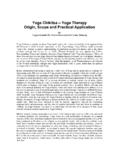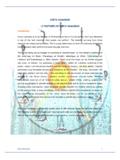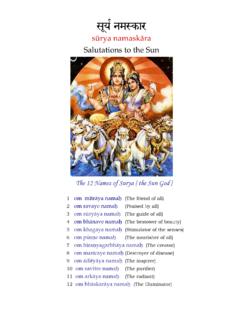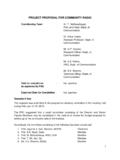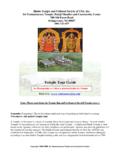Transcription of Principle and methods - ICYER
1 principles . AND. methods . OF YOGA PRACTICES. STUDY MATERIALS. COMPILED AND EDITED. BY. Yogachemmal Sri G DAYANIDY and Smt REENA DAYANIDY. Under guidance of Yogacharya Dr ANANDA BALAYOGI BHAVANANI. , , , , , , CHAIRMAN. INTERNATIONAL CENTRE FOR YOGA EDUCATION AND. RESEARCH AND YOGANJALI NATYALAYAM. PUDUCHERRY, SOUTH INDIA. and YOGIC PRACTICES. Yoga is a science of right living, and as such, it is intended to be incorporated in daily life. It works on all aspects of the person.. the physical, mental, emotional, social and spiritual levels. The word Yoga means Unity or Oneness . It is derived from the Sanskrit word YUJ which in spiritual terms mean the union of the individual consciousness with the universal consciousness. On a more practical level, yoga is a means of balancing & harmonizing the body, mind & emotions and this state need to be achieved before union with the higher reality takes place.
2 Maharishi Patanjali In Yoga Sutras Maharishi Patanjali replies to the question of "What is yoga?" as, Atha yoga anushasanam - yoga is a form of discipline. The word for discipline in Sanskrit is anushasanam. The word Anu means 'atom', the most tiny and subtle one. We know the nature of an atom is invisible yet potent. Shasanam means 'to rule over' or 'to govern'. So, the concept of discipline in Yoga is a process in which we learn to govern the subtlest aspect, the unknown aspect of our own selves. Maharishi Patanjali quotes the result of this discipline as, Yogaha chitta vritti nirodhaha . Through this discipline we will gain control over the different modifications of Chitta. Chitta means the aspect which observes, which sees, which is consciously active in the world.
3 The aim of the yogic discipline is to alter the Vrittis. Our mind is disturbed by the Chitta Vrittis (the five mental afflictions) which needs to be controlled. The five Mental Afflictions are: Pramana : Right knowledge Viparyaya : Wrong knowledge Vikalpa : Imagination Nidra : Sleep Smriti : Memory principles AND methods OF YOGA PRACTICES. (C) Principle & methods of Yoga Teaching 2. "What is the aim of Yoga?" - The aim of Yoga is not only to control the Vrittis, but in turn by controlling the Vrittis obtaining a state of union with the Paramatma. DIVINE TRANSFORMATION. Yogacharini Meenakshi Devi Bhavanani DIVINE. H UMANE. MAMMALIAN. REPTILIAN. principles AND methods OF YOGA PRACTICES. (C) 3 Yogic Practices Swami Gitananda defines Yoga as Way of life.
4 He also gives us the four/ fivefold awareness: Awareness of body Awareness of mind Awareness of emotions Awareness of awareness itself Of course before this we have to first have the Yoga Maharishi Awareness of how unaware we are Swami Gitananda Giri Yogic practices thus help us to develop kinesthetic awareness and lead a yogic life. CONCEPT OF YOGIC PRACTICES. The term Yoga carries several technical meanings. One of its principal meanings is Yukti'. Yukti means technique, trick or skill for achieving the goal indirectly when the goal cannot be achieved directly. Yoga as Yukti can also be termed as a junction in order to feel the divine within us. Yoga as Yukti involves many different processes which require proper training. So the techniques or practices ( , yuktis) enjoined in yogic literature also go under the name of Yoga.
5 Thus we get such terms as Laulika Yoga, Neti Yoga, Dhyana Yoga, Samadhi Yoga etc., for the individual yoga practitioner. When various such techniques or practices are systematized and formulated they are known as schools of yoga like Bhakti Yoga, Jnana Yoga, Karma Yoga, Hatha Yoga, Laya Yoga, Raja Yoga etc., all these schools of Yoga are only Yoga in the sense of so many techniques, Yuktis or Yogic practices. The four major schools or streams of Yoga are: (i) Karma Yoga Path of Self Sacrifice (ii) Bhakti Yoga Path of self Surrender (iii) Jnana Yoga Path of Self Analysis (iv) Raja Yoga Path of Self Control. The nature of all Yogic practices is psycho-physiological. Although every Yogic practice is psycho-physiological in nature, those practices which emphasis control of mental processes directly are more psychological.
6 Some yogic practices of Hatha Yoga are more physical or physiological than psychological. Only these yogic practices which predominantly are physical or physiological in nature could be referred to as exercises. Rather, they should be understood in the sense of what is called the hygienic exercises. Some of the yogic exercises are Surya Namaskar, Asana, Pranayama, Mudras, Bandhas and Shat kriya. principles AND methods OF YOGA PRACTICES. (C) Principle & methods of Yoga Teaching 4. TYPES OF YOGIC PRACTICES. Yogic practices begin to work on the outmost aspect of the personality. The physical body is the practical and familiar starting point for most of the people. When imbalance is experienced at this level, the organs, muscles & nerves no longer functions in harmony, rather they act in opposition to each other.
7 Yogic practices helps to overcome these imbalances and create harmony in the body and mind. In Bhagavad Gita Yogeshwar Krishna defines yoga as Samatvam yoga ucchyate - Equanimity of mind. Yogaha karmasu koushalam - Yoga is skill in action. Doing everything skillfully is also the main aim of Yoga. Yogic practices help in attaining the attitude of perfection in the mind. The various types of Yogic practices from which everyone can get benefited are: (i) Yama and Niyama (Attitude Training Practices). (ii) Asana (Steady Postures). (iii) Pranayama (control of the breathing process). (iv) Mudras and Bandhas (seal and lock for energy). (v) Shat Kriya (six purification techniques). (vi) Dhyana (Meditation). Attitude Training Practices (Yama and Niyama).
8 Yama and Niyama are the fundamental practices of yoga. Without them, other Yogic practices fail to give desired results. Yama and Niyama are self-imposed restrictions to govern our behaviour and thus develop a healthy attitude towards life, objects and circumstances. The cultivation of correct psychological attitudes through Yama and Niyama bring about tranquilization of the mind. It is an attempt to cultivate and maintain mental peace. According to Yoga, the influence of mind over the body is much more than that of the body over the mind. So this lays a special emphasis on Yama and Niyama and gives the top priority among various yogic practices. The Pancha Yamas are the five moral restraints and Pancha Niyamas are the five evolutionary observances.
9 principles AND methods OF YOGA PRACTICES. (C) 5 Yogic Practices Asana (Steady Posture). The term Asana is derived from the Sanskrit term Asi to be' or to sit'. Asanas are certain special patterns of postures that stabilize the body and mind. They aim at establishing a proper rhythm in the neuromuscular tonic impulses and improving the general muscle tone. Asanas help in the healthy functioning of the organism and also leads to suppleness and ease of movement. Asana benefits the physical body and brings in emotional stability in the human being. Pranayama (Control of the Breathing Process). The term Pranayama is derived from two root words Prana' which means vital energy or life force and Ayama' which means extension or expansion.
10 So the word Pranayama means extension of the vital force ( dimension of Prana) Pranayamas are practices that are designed to bring about voluntary control over respiration. The main purpose of Pranayama is to gain control over the autonomous nervous system through breath control and by it influence the mental function. It is useful in higher Yogic practices like Meditation. Mudras and Bandhas (seal and lock for energy). Mudras and Bandhas are certain specific locks and holds of the semi-voluntary and involuntary muscles in the body. By bringing these muscles more and more under volition, one could there by influence the activity of the autonomous nervous system as a whole. They also involve manipulation of internal pressure on the negative or positive side of the body.


